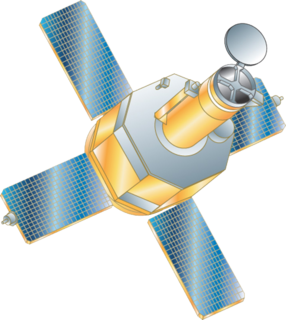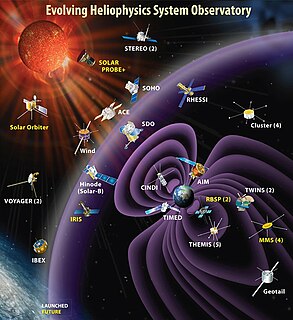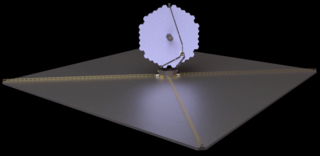Related Research Articles

The Goddard Space Flight Center (GSFC) is a major NASA space research laboratory located approximately 6.5 miles (10.5 km) northeast of Washington, D.C. in Greenbelt, Maryland, United States. Established on May 1, 1959 as NASA's first space flight center, GSFC employs approximately 10,000 civil servants and contractors. It is one of ten major NASA field centers, named in recognition of American rocket propulsion pioneer Robert H. Goddard. GSFC is partially within the former Goddard census-designated place; it has a Greenbelt mailing address.

NASA's series of Great Observatories satellites are four large, powerful space-based astronomical telescopes launched between 1990 and 2003. They were built with different technology to examine specific wavelength/energy regions of the electromagnetic spectrum: gamma rays, X-rays, visible and ultraviolet light, and infrared light.

Transition Region and Coronal Explorer (TRACE) was a NASA heliophysics and solar observatory designed to investigate the connections between fine-scale magnetic fields and the associated plasma structures on the Sun by providing high resolution images and observation of the solar photosphere, the transition region, and the corona. A main focus of the TRACE instrument is the fine structure of coronal loops low in the solar atmosphere. TRACE is the fourth spacecraft in the Small Explorer program, launched on April 2, 1998, and obtained its last science image on 21 June 2010 23:56 UT.

The Center for Astrophysics | Harvard & Smithsonian (CfA) is an astrophysics research institute jointly operated by the Harvard College Observatory and Smithsonian Astrophysical Observatory. Founded in 1973 and headquartered in Cambridge, Massachusetts, the CfA leads a broad program of research in astronomy, astrophysics, Earth and space sciences, as well as science education. The CfA either leads or participates in the development and operations of more than fifteen ground- and space-based astronomical research observatories across the electromagnetic spectrum, including the forthcoming Giant Magellan Telescope (GMT) and the Chandra X-ray Observatory, one of NASA's Great Observatories.
Solar physics is the branch of astrophysics that specializes in the study of the Sun. It deals with detailed measurements that are possible only for our closest star. It intersects with many disciplines of pure physics, astrophysics, and computer science, including fluid dynamics, plasma physics including magnetohydrodynamics, seismology, particle physics, atomic physics, nuclear physics, stellar evolution, space physics, spectroscopy, radiative transfer, applied optics, signal processing, computer vision, computational physics, stellar physics and solar astronomy.
The Lockheed Martin Solar and Astrophysics Laboratory (LMSAL) is part of the Lockheed Martin Advanced Technology Center (ATC) that is known primarily for its scientific work in the field of solar physics, astronomy and space weather. The LMSAL team is part of Lockheed Martin Space Systems and has close affiliations with NASA and the solar physics group at Stanford University.

The Solar Dynamics Observatory (SDO) is a NASA mission which has been observing the Sun since 2010. Launched on 11 February 2010, the observatory is part of the Living With a Star (LWS) program.

The Time History of Events and Macroscale Interactions during Substorms (THEMIS) mission began in February 2007 as a constellation of five NASA satellites to study energy releases from Earth's magnetosphere known as substorms, magnetic phenomena that intensify auroras near Earth's poles. The name of the mission is an acronym alluding to the Titan Themis.

Heliophysics is the science of the physical connections between the Sun and the Solar System. NASA defines heliophysics as "(1) the comprehensive new term for the science of the Sun - Solar System Connection, (2) the exploration, discovery, and understanding of Earth's space environment, and (3) the system science that unites all of the linked phenomena in the region of the cosmos influenced by a star like our Sun."

Goddard Space Flight Center is NASA's first, and oldest, space center. It is named after Dr. Robert H. Goddard, the father of modern rocketry. Throughout its history, the center has managed, developed, and operated many notable missions, including the Cosmic Background Explorer, the Hubble Space Telescope, the Tracking and Data Relay Satellite System (TDRSS), the Lunar Reconnaissance Orbiter, and the Solar Dynamics Observatory.

The history of X-ray astronomy begins in the 1920s, with interest in short wave communications for the U.S. Navy. This was soon followed by extensive study of the earth's ionosphere. By 1927, interest in the detection of X-ray and ultraviolet (UV) radiation at high altitudes inspired researchers to launch Goddard's rockets into the upper atmosphere to support theoretical studies and data gathering. The first successful rocket flight equipped with instrumentation able to detect solar ultraviolet radiation occurred in 1946. X-ray solar studies began in 1949. By 1973 a solar instrument package orbited on Skylab providing significant solar data.

The Interface Region Imaging Spectrograph (IRIS), also called Explorer 94, is a NASA solar observation satellite. The mission was funded through the Small Explorer program to investigate the physical conditions of the solar limb, particularly the chromosphere of the Sun. The spacecraft consists of a satellite bus and spectrometer built by the Lockheed Martin Solar and Astrophysics Laboratory (LMSAL), and a telescope provided by the Smithsonian Astrophysical Observatory. IRIS is operated by LMSAL and NASA's Ames Research Center.

Madhulika (Lika) Guhathakurta is an American Astrophysicist and scientist with NASA's Heliophysics Science Division. She was the lead program scientist for NASA's Living With a Star initiative and serves as program scientist on the Solar Dynamics Observatory (SDO), Van Allen Probes, and Solar TErrestrial Relations Observatory (STEREO) missions. Lika was previously the program scientist on SPARTAN-201, a free-flying science instrument platform designed to study velocity and acceleration of the solar wind and observe the sun's corona. These missions were conducted as part of the larger STS-56, STS-69, STS-77, STS-87, and STS-95 mission objectives. She has worked as an educator, scientist, mission designer, directed and managed science programs, and has built instruments for spacecraft. Dr. Guhathakurta is known for her work in heliophysics where she has authored over 70 publications on the subject. She served as the NASA Lead Scientist for the North American Solar eclipse of August 21, 2017.

The Heliophysics Science Division of the Goddard Space Flight Center (NASA) conducts research on the Sun, its extended solar system environment, and interactions of Earth, other planets, small bodies, and interstellar gas with the heliosphere. Division research also encompasses geospace—Earth's uppermost atmosphere, the ionosphere, and the magnetosphere—and the changing environmental conditions throughout the coupled heliosphere.

Joan T. Schmelz is the Associate Director for Science and Public Outreach at the Stratospheric Observatory for Infrared Astronomy (SOFIA) for the Universities Space Research Association (USRA). Previously, Schmelz was the Deputy Director of Arecibo Observatory and the Director of USRA Operations at Arecibo from 2015 through 2018. Before joining USRA, Schmelz was an NSF Program Director in the Astronomical Sciences Division, where she oversaw the Astronomy & Astrophysics Postdoctoral Fellowship program, and a professor of physics at the University of Memphis from 1996 to 2017. Schmelz's research focus is heliophysics, specifically investigating the coronal heating problem as well as the properties and dynamics of the solar atmosphere. She uses spectroscopic and image data in the X-ray and ultraviolet wavelength ranges obtained from NASA satellites and rockets. She has published over 80 refereed scientific journal articles and authored three books.

The Large Ultraviolet Optical Infrared Surveyor, commonly known as LUVOIR, is a multi-wavelength space telescope concept being developed by NASA under the leadership of a Science and Technology Definition Team. It is one of four large astrophysics space mission concepts being studied in preparation for the National Academy of Sciences 2020 Astronomy and Astrophysics Decadal Survey. While LUVOIR is a concept for a general-purpose observatory, it has the key science goal of characterizing a wide range of exoplanets, including those that might be habitable. An additional goal is to enable a broad range of astrophysics, from the reionization epoch, through galaxy formation and evolution, to star and planet formation. Powerful imaging and spectroscopy observations of Solar System bodies would also be possible. LUVOIR would be a Large Strategic Science Mission and will be considered for a development start sometime after 2020. The LUVOIR Study Team has produced designs for two variants of LUVOIR: one with a 15.1 m diameter telescope mirror (LUVOIR-A) and one with an 8 m diameter mirror (LUVOIR-B). LUVOIR can observe ultraviolet, visible, and near-infrared wavelengths of light. The Final Report on the 5-year LUVOIR mission concept study was publicly released on 26 August 2019.
The X-Ray Imaging and Spectroscopy Mission, formerly the X-ray Astronomy Recovery Mission (XARM), is an X-ray astronomy satellite of the Japan Aerospace Exploration Agency (JAXA) to provide breakthroughs in the study of structure formation of the universe, outflows from galaxy nuclei, and dark matter. As the only international X-ray observatory project of its period, XRISM will function as a next generation space telescope in the X-ray astronomy field, similar to how the James Webb Space Telescope, Fermi Space Telescope, and the Atacama Large Millimeter Array (ALMA) Observatory are placed in their respective fields. The mission is a stopgap for avoiding a potential observation period gap between X-ray telescopes of the present and those of the future. Without XRISM, a blank period in X-ray astronomy may arise in the early 2020s due to the loss of Hitomi. During its formulation, XRISM/XARM was also known as the "ASTRO-H Successor" or "ASTRO-H2".
Anne L. Kinney is an American space scientist and educator. Kinney is currently the Deputy Center Director at NASA Goddard Space Flight Center. Previously, she held positions as the head of the Directorate for Mathematical and Physical Sciences (MPS) for the National Science Foundation (NSF), the Chief Scientist of the W.M. Keck Observatory, Director of the Solar System Exploration Division at NASA Goddard Space Flight Center, Director of the Origins Program at NASA Jet Propulsion Laboratory, and Director of the Universe Division at NASA Headquarters. She earned a bachelor's degree in astronomy and physics from the University of Wisconsin-Madison and a doctorate in astrophysics from New York University, and has published more than 80 papers on extragalactic astronomy. She was an instrument scientist for the Faint Object Spectrograph that flew on the Hubble Space Telescope.
Peter Thomas Gallagher is an Irish astrophysicist. He specialises in solar physics, notably solar storms and their impact on the Earth. He is Senior Professor, and Head of Astronomy and Astrophysics, at the Dublin Institute for Advanced Studies, director of Dunsink Observatory, and an adjunct professor at Trinity College Dublin. He is also the head of the radio-telescope project I-LOFAR, at Birr Castle. He is widely cited in his field and often quoted in the media.
References
- ↑ "Richard Royal Fisher '61, Doctor of Science | Grinnell College". www.grinnell.edu. Retrieved 2019-08-04.
- 1 2 3 NASA. "Bio - Richard R. Fisher".
- 1 2 Smithsonian National Air and Space Museum. May 23, 2014. Video: How Skylab Changed Solar Astronomy into Heliophysics. Introductory remarks by Paul E. Ceruzzi. from 0 to 3:10. See 3:05 into the video for the quotation.
- ↑ Warren E Leary for the New York Times. October 20, 1998 Two Satellites to Study Sun During Discovery Mission
- ↑ NASA Clear Weather Bios page accessed April 3, 2016
- ↑ NASA Advisory Council. Heliophysics Subcommittee. NAC Heliophysics Subcommittee Meeting Minutes, June 20-22, 2011
- ↑ Amy Klamper, Space News Staff Writer. October 5, 2010 NASA Can’t Afford Senate's Timeline for Solar Probe
- ↑ CNN. February 11, 2010 NASA launches Solar Dynamics Observatory
- ↑ John Matson for Scientific American. April 21, 2010 NASA's Solar Dynamics Observatory producing sun science that doubles as eye candy
- ↑ Daniel Cressey for Nature News. 22 Apr 2010 Solar Science Satellite’s Super Sun Snaps
- ↑ Alexis Madrigal for Wired. April 21, 2010 New Space Telescope Delivers First Mind-Blowing Video Of The Sun
- ↑ Andrew Hough for the Telegraph 14 Jun 2010 NASA warns solar flares from 'huge space storm' will cause devastation
- ↑ Betsy Mason for Wired. Feb 17, 2010 NASA Brings The Dark Side Of The Sun To Your IPhone